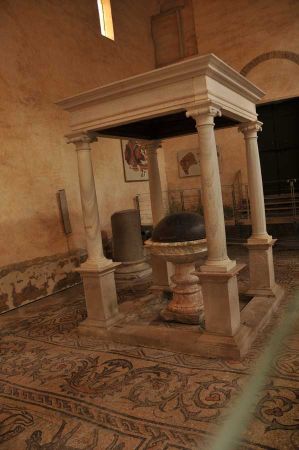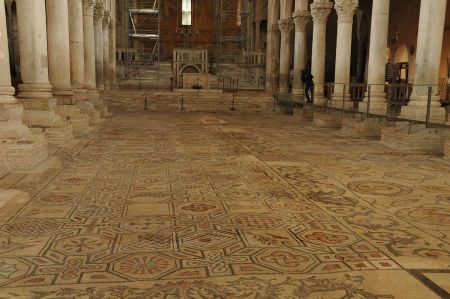Aquileia - floor mosaic in the cathedral
- Written by Portal Editor
Our project trip should also take us to the ancient Roman city of Aquileia in what is now the province of Udine, where there is a huge excavation site to visit as well as two museums, one of which is on early Christian history.
The planned days of stay in Aquileia were, however, intended both to visit the Roman sites and to explore the immediate surroundings with the "Foce dell`Isonzo" nature park, as Aquileia is expanding the regional cycle path network thanks to EU funding and is also connected to Austria and Germany via a cycle path is. A good example of the linking of cultural heritage with implemented outdoor activities, which we wanted to include as a successful example in our project.
The ancient city of Aquileia was a port city on the once mighty Natissa River (Natisone-Torre) in what is now Friuli in northern Italy, not far from the border with Slovenia. After the attempt at a Celtic settlement had been stopped, founded in 181 BC. About 3,000 veterans of the Roman army based on a senate resolution a military colony according to Latin law, "in agro gallorum" as a military bridgehead for the Roman conquest of the Danube region. The continuously increasing importance of the city resulted from its function as an important traffic junction, which later led to the award of the title "Municipium". Today Aquileia is a small town with just 3,400 inhabitants, the formerly mighty river is now just a small river due to silting up and changing the course of the river.
For travelers and traders in antiquity, Aquileia was the first major city in Italy after crossing the gate of Postojna from the southeast or crossing the pass of the Birnbaumer forest in the Julian Alps. This is also the end point of the famous Amber Road coming from the north: The Roman writer Pliny the Elder reported in his notes that amber was transported from the Baltic Sea to Aquileia. The city was also on the way to the province of Noricum, which was of great importance for the Roman Empire due to mining.
Due to its central location, the city also long formed a bulwark against the "barbarians" from the north and east, who were attacking again and again, as the enemies of Rome were often described. Emperor Mark Aurel had his headquarters here in Aquileia in 168 at the beginning of the Marcomann Wars. During the First Marcomann War, Aquileia was besieged in 170 by the Marcomanni and Quadas who had invaded northern Italy.
At the beginning of the imperial crisis of the 3rd century, in 238, the city of Aquileia sided with the Senate in the fight against the then reigning Emperor Maximinus Thrax. He moved against Italy, but was killed by his own troops during the siege of Aquileia. In 270, Emperor Quintillus moved to Aquileia to use it as a headquarters for his armed forces after the usurper Aurelian claimed the dignity of emperor for himself. However, the troops of Quintillus defected to Aurelian, which is why the emperor committed suicide or, as other sources claim, was also murdered by his own soldiers.
In 452 the city was destroyed by the Huns under their leader Attila.
Under the Lombards, Aquileia lost its role as a political and military center with the establishment of the Duchy of Cividale. Instead of Aquileia with its swampy and unsafe location in a sand-washed harbor during the migration of peoples, Grado, located on the nearby lagoon island, was preferred. With the rise of Venice, Aquileia finally lost its dominance.
The Gospel was preached from Aquileia in the Alpine region, so the first Christians came from Aquileia in Säben. Carinthia, south of the Drau, was pastoral care and canonical administered by the shepherd Aquileias from the Carolingian period until the abolition of the patriarchate. The place name Hermagor in Carinthia goes back to the first bishop Aquileias.
National Archaeological Museum of Aquileia
On the ground floor of the villa there is a collection of stone monuments, with statues, busts, inscriptions and reliefs. On the first and second floors of the villa, jewelry and various Roman-ancient art objects made of glass, amber, bronze, gold, ceramics and engraved stone are exhibited, which document everyday life in ancient Aquileia.
The lapidarium is located in the garden of Villa Cassis. The stone gallery consists of mosaics, urns, tombstones and architectural ornaments. Some of the mosaics were set into the floors. Some of the architectural elements, which mainly come from public buildings in the forum, from tombs and inscriptions, are arranged in chronological order.
Aquileia Cathedral
The basilica houses one of the most extraordinary multicolored floor mosaics of the 4th century in our world. This huge mosaic area was brought to light in the years 1909-1912. Of the two mighty halls attributed to Bishop Teodoro, one is said to have been used as a church and the other as a room for the religious instruction of the baptized. Further adjoining rooms completed and connected the two halls.
The attentive observation of the symbols of animals, plants, people, shapes and braids shown here, which are sometimes difficult to interpret and perhaps not all Christian, served as an incentive for those who chose a new faith as an adult and should reinforce their decision . The frescoes in the apse, which have almost been preserved in the original, should also be viewed carefully.
Today it is believed that Aquileia had 70,000-100,000 inhabitants at the end of the imperial era: it was the fourth largest Roman city in Italy and the ninth largest in the entire Roman Empire. Christianity came early to Aquileia, which then became the center of the spread of the new faith.
In addition to all the history, there is a really interesting environment that makes a longer stay very pleasant.
Please also read the following articles:
The bicycle project "Ciclovia Alpe Adria Radweg"
Staranzano bike tour through the Foce dell`Isonzo nature reserve
-
-
-
-
-
-
-
-
-
-
-
-
-
-
-
https://www.alaturka.info/en/italy/trieste/5291-aquileia-floor-mosaic-in-the-cathedral/amp#sigProId637d28294b
